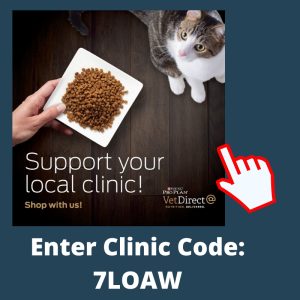Cat Facts
What food should I feed my cat?
Canned foods! Here’s why… The cat is an obligate carnivore. In order to maintain optimal health, a carnivore requires a diet high in protein and minimal in carbohydrates. The cat is metabolically adapted to use protein and fat as energy sources. Carbohydrates become stored as fat. Dry foods have greater carbohydrate concentrations because starch is necessary to make the kibble. In fact, the carbohydrate content of dry food is approximately 35-40% vs. only 10-18% in canned food.
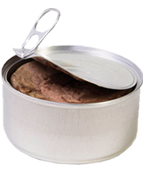
Considering the pet cat population, over 50% are overweight! Obesity predisposes these patients to a number of disease processes including diabetes, urinary tract disease, joint problems, fatty liver disease, non-allergic skin conditions, and inflammatory bowel disease. The way to help these cats maintain lean body mass and lose weight is to feed them high- protein, low-carbohydrate diets. In short, FEED THEM CANNED FOODS!
When choosing canned foods avoid the fish-flavored foods and those containing gravies or sauces. Fish-flavored foods are high in magnesium and can alter the urine pH, and the gravy is carbohydrate-rich. Offer your cat meat-flavored canned foods to help maintain optimal health!
LITTER BOX TIPS
Here are some tips for making your cat’s litter box a place they will want to go:
- Type of Litter: Unscented clumping litter is recommended and preferred by most cats. While to our nose a scented litter may be more pleasing, a cat may find the odor unappealing and overwhelming. Cats are very sensitive to smells. Most cats prefer clumping clay litter. To find out your cat’s litter preference, try offering different options in a variety of litter boxes and keep the one that gets used the most.
- Scoop the litter box at least once a day- twice is best. Cats don’t like dirty toilets. Dump out all the litter and wash out the entire box with soap and water at least once a month (once a week if it’s not the clumping litter).
- How many litter boxes should I have? Ideally there should be one more box per household than the number of cats in the household. Even if you only have one cat, there should be two boxes in the house.
- Should I use litter box liners? We do not recommend litter box liners, as some cats don’t like the feel of the plastic. Also they can hinder with cleaning of the litter boxes, can hold in the smell, and may cause the cat to not be able to identify that it is their box.
- Type of litter box: Most cats do not prefer covered litter boxes. It can make the cat feel trapped, as there is only one exit. There are many varieties of sizes and heights of litter boxes. Supersize the boxes. Many litter boxes don’t offer enough elbowroom for bigger or overweight cats. A plastic storage container (under the bed container) may be used instead. If the cat stands in the box but the urine ends up out of the box, try using a plastic storage box with high sides with an opening (that is not sharp) cut out so the cat can easily get in and out.
- Where should I put the litter box? Location does matter. The litter boxes should be placed in a quiet secluded area, but still be able to offer the cat a view of what is going on around them. Place the litter boxes away from the commotion of the household, loud appliances, dogs and children.
- Cleaning the litter box: We recommend using hot soapy water. Do not use bleach or any harsh chemicals. The idea is for your cat to still be able to smell that this is their box.
Is it safe for kids to scoop the litter box? We do not recommend that children or people with compromised immune systems scoop the litter box. The reason for this is that there are some intestinal parasites that are zoonotic (passed from animals to humans) and can cause serious diseases in humans. It is recommended to practice good hygiene by washing your hands after handling any fecal material from your cat. It is also important to have your cat’s stool sample checked for intestinal parasites at least once a year, even if your cat is an “indoor only” cat. If your cat does go outside, then it is recommended to routinely deworm your cat for intestinal parasites by using either Revolution or Profender.
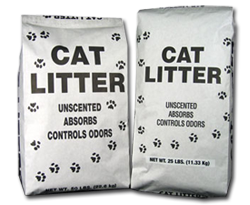
What about bathing & grooming?
Cats are such fastidious groomers that we recommend bathing only if they should “get into something”. Excess bathing can dry their skin and remove the natural oils from their coat. Cats with long hair should be combed or brushed on a daily basis to help prevent matting and clumping of the hair. Shorthaired cats should be brushed weekly with a fine-toothed comb or soft brush.
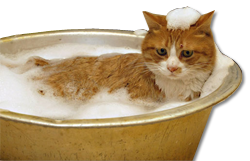
10 SIGNS OF ILLNESS
- Changes in Interaction- Examples include a clingy cat that is now acting aloof, or a normally independent cat that is now acting very clingy. Also if your cat is acting aggressive or more irritable when handled or touched in certain areas.
- Changes in Activity- A decrease or increase in the cat’s activity or a change in the cat’s daily routine can be a sign of a medical condition.
- Changes in Chewing or Eating Habits- Monitor your cat for either a increase or decrease in how much they are eating. Increased appetite can be a sign or symptom of hyperthyroidism, diabetes mellitus, or other health problems. Decreased appetite can be a sign or symptom of many medical disorders ranging from dental problems to cancer. Drooling, pawing at the face, exaggerated chewing or chewing on one side of the mouth can also be a sign or symptom of dental disease.
- Changes in Water Intake- Drinking more or less water can be a sign of health problems, such as kidney problems or diabetes.
- Unexpected Weight Loss or Weight Gain- Weight may not always correlate with a change in appetite. Cats may lose weight despite having an increased appetite with some medical conditions such as hyperthyroidism and diabetes.
- Bad Breath- may be a sign of dental and or gum disease, or even a digestive disorder, infection or kidney disease.
- Changes in Grooming Habits- Fastidious groomers that are no longer grooming may be ill. Over grooming and creating bald spots, or thinning fur may be related to stress, pain or a skin disease. When a cat is grooming less than normal, you may notice more fur mats, a greasy hair coat or just an overall “unkempt” appearance.
- Changes in Sleeping Habits- From sleeping more often to being awake more in the night. Some cats will start to vocalize or “yowl” more at night. You may find your cat sleeping in unusual places when they are not feeling well- or even that they appear restless like they cannot get comfortable enough to rest.
- Changes in Vocalization- Cats that suddenly start vocalizing or yowling in the middle of the night may be a sign or symptom of a medical problem such as Feline Cognitive Dysfunction Syndrome, kidney disease, or hyperthyroidism. Also signs or symptoms of illness could be a change in the tone or sound of your cat’s meows and vocalizations. A cat that is usually quiet that is now vocalizing constantly or vice versa is also a symptom or sign of illness.
- Changes in the Litter Box- This can include either changes in the frequency or consistency of what your cat produces in the litter box, or a change in the way your cat is using the litter box. If a normally very well trained cat starts to have accidents outside the litter box- this could be a sign of a new medical condition, or stress.
- Stool- Changes in the consistency and regularity are important to note in your cat. Stool that is either too soft or too hard can be a sign or symptom of gastrointestinal illness or intestinal parasites.
- Urine- Changes in urine production are important to note. If your cat is urinating very small amounts frequently could be a sign of bladder inflammation (cystitis), or a urinary tract infection. Urinating large amounts at a time could be a sign or symptom of feline diabetes or kidney disease. If you are uncertain if your cat is urinating at all this should be treated as an emergency and your cat should be seen by a veterinarian right away.
General Health Care
One of the most beneficial reasons for yearly Veterinary visits is the physical exam your pet receives. Remeber, cats age more rapidly than humans!
How Old is Your Cat in “Human” Years??
|
|
|
PREVENTITIVE MEDICINE is our goal.
Early detection of diseases may prolong your pets life span.
Yearly physical exams include:
- Heart
- Coat & Skin
- Ears
- Nose and Throat
- Mouth, Teeth, & Gums
- Legs and Paws
- Lungs
- Abdomen
- Lymph Nodes
- Urogenital Systems
- Nervous System
- Weight
- Client Education

New Cat Check List
Here are a few things to do before bringing a new cat into your home:
-
Ask your Veterinarian to check the new cat for diseases such as FIV and Fel V, which could infect other cats.
-
Vaccinate the cat against rabies and common cat diseases.
-
Make a litter box accessible, but not too close to the cat’s food dishes. If you have more than 1 cat, use several boxes-1 per cat if possible.
-
Place scratching posts or pads in strategic locations so your cats can use them as alternative to upholstered furniture.
-
Establishing more than one “dining area” if your cats show a preference for eating seperately.
-
Provide variety. Cats find it easier to share a house that has many lookouts, hideouts, and comfortable “nests”.
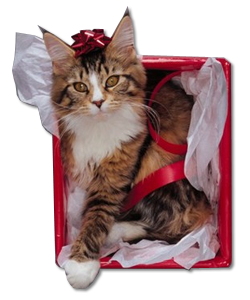
How to “Kitten Proof” your house.
Kittens are naturally inquisitive, which can often lead to serious injury. Here are some tips on how you can make your house safer for the new arrival:
-
That’s shocking! Kittens love to chew when teething. Keep electrical wires out of reach, or use a pet-repellant spray to coat the wires.
-
They’d die for some chocolate! Chocolate can be dangerous. It contains Theobromine, a powerful stimulant that is toxic to pets. Sweets, cakes and cookies can also upset the G.I. tract and lead to diarrhea and vomiting.
-
Treats can be threats! Never give turkey, chicken, or rib bones as a treat. They can splinter and cause serious injury.
-
Common household killers – Cleaning agents, bleach, ammonia, disinfectants, drain cleaner, oven cleaner, gasoline, rat poision..Keep the all locked up!
-
Check the anti-freeze! Pets are attracted to the odor and sweet taste of anti-freeze. Store it high and tightly sealed, wiping any spills on the garage floor. Window-washing solution also contains anti-freeze. And remember, engine warmth promotes cat naps, so honk your horn to wake pets under the hood.
-
Killer house plants – Poisonous plants include many from the lily family! See toxic plant list below.
-
Keep of the grass! If you treat your lawn with chemicals, keep pets away.
-
It fit yesterday! Collars and harnesses can be rapidly outgrown, leading to serious wounds. Check your cat’s collars regularly, especially on that growing kitten! Two fingers should easily fit underneath the collar.
-
Personal care items and medications – Cosmetics, shampoos, skin creams, hair solutions, depilatories, suntan lotions, sleeping pills, antihistamines, asprin and acetaminophen can all be lethal.
-
It’s not a toy! Do not leave plastic bags out! Inquisitive young animals, especially kittens, can suffocate or get thier neck caught in the handles!
-
The heat is on! Watch out for hot irons, coffee pots, space heaters, stove tops…Kittens will soon be able to jump to new heights.
-
A dip tip-Keep covers on hot tubs and swimming pools. Kittens can easily fall in and not be able to get out!
-
Kittens are attracted to warmth. Be very cautious when doing laundry because they can sneak into the dryer very easily without your knowing it.
-
Br-r-r-r-r-r it’s cold in there! Curious kittens have been known to get into everything including the refrigerator! Be careful! A great idea is to have a little bell on your cats collar so you know of his/her whereabouts all the time.
-
‘Tis the season! Keep holly, mistltoe and especially Christmas tree tinsel out of reach.
-
Cozy up! Always use a fireplace screen.
-
Do you eat with that mouth? If any or all of something will fit in a mouth, it’s dangerous. Watch out for cigarette butts, rubber bands, balloons, sewing needles, thread, string, ribbons, pantyhose…because what goes in must come out, often via surgery.
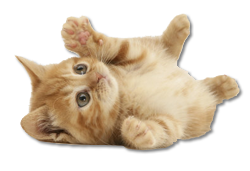
Plants to avoid/Poisonous plants.

Autumn Crocus, Azalea, Baby’s Breath, Bird of Paradise, Branching Ivy, Buckeye, Buddhist Pine, Caladium, Calla Lily, Castor Bean, Ceriman, Charming Dieffenbachia, Cherry (seeds and wilting leaves), Chinese Evergreen, Christmas Rose, Cineraria, Clematis, Cordatum, Corn Plant, Croton, Cuban Laurel, Cutleaf Philodendron, Cycads, Cyclamen, Daffodil, Devil’s ivy, Dieffenbachia, Dracaena Palm, Dragon Tree, Dumb Cane, Easter Lily, Elaine, Elephant Ears, Emerald Feather, English Ivy, Eucalyptus, Fiddle-leaf Fig, Florida Beauty, Foxglove, Fruit Salad Plant, Geranium, German Ivy, Giant Dumb Cane, Glacier Ivy, Gold Dust Dracaena, Golden Pothos, Hahn’s Self-branching Ivy, Heartland Philodendron, Hurricane Plant, Indian Rubber Plant, Janet Craig Dracaena, Japanese Show Lily, Jerusalem Cherry, Kalanchoe, Lacy Tree Philodendron, Lily of the Valley, Madagascar Dragon Tree, Marble Queen, Marijuana, Mexican Breadfruit, Miniature Croton, Mistletoe, Morning Glory, Mother-in-Law’s Tongue, Narcissus, Needlepoint Ivy, Nephthytis, Nightshade, Oleander, Orion, Oriental Lily, Peach (wilting leaves and pits), Pencil Cactus, Plumosa Fern, Poinsettia (low toxicity), Poison Ivy, Poison Oak, Pothos, Precatory Bean, Primrose, Red Emerald, Red Princess, Red-margined Dracaena, Rhododendron, Ribbon Plant, Saddle Leaf Philodendron, Sago Palm, Satin Pothos, Schefflera, Spotted Dumb Cane, String of Pearls, Sriped Dracaena, Sweetheart Ivy, Swiss Cheese Plant, Taro Vine, Tiger Lily, Tomato Plant (green fruit, stem, leaves), Tree Philodendron, Tropic Snow Dieffenbachia, Weeping Fig, Yew.
How to choose an appropriate cat toy?
When picking out cat toys you should be careful with what you choose. Cats and kittens at any age can find things around the house that are dangerous. Your cat, like a child, will put anything and everything in their mouth. Remember, anything that will fit in your cat’s mouth is dangerous, and whatever goes in must come out (often via surgery).
Here is a list of cat toys to buy and ones to stay away from:
UNSAFE CAT TOYS:
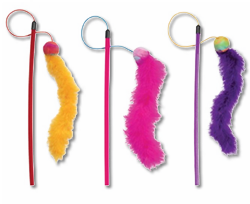
String
Yarn
Ribbon
Rubber Bands
Thread
Balloons
Q-Tips
Cotton Balls
Shoelaces
Tinsel
Plastic Bag
Nerf Balls
Nipples from Baby Bottles
SAFE CAT TOYS:
Laser Pointer
Large Toy Mice
Catnip Toys
Plastic Balls with Bells
Remote Control Mouse
Feline Flyers
Paper Balls
Paper Bags WITHOUT THE HANDLES
Scratching Post for Climbing
Foil Balls
Dental Care for a Healthy Cat
By the age of two, 70% of cats show signs of oral disease. Oral disease can eventually lead to gingival recession, oral pain, tooth loss or many other serious health problems for your cat. This oral disease is preventable with proper home care and routine professional cleanings.
All cats should have a comprehensive physical examination yearly, which will include a dental health evaluation. Most cats need a complete professional dental cleaning and fluoride treatment every 1 to 2 years. Screening full-mouth radiographs, or x-rays, are advised for your cat at least every other year to ensure a healthy mouth. Regular home dental care, such as teeth brushing, can help in keeping your cat’s mouth healthy in between cleanings. Our staff can help assist you in starting a home dental care plan.
Plaque is a tan, thick substance consisting of saliva, bacteria and food particles. Plaque is 80% bacteria and sticks to the teeth and collects below the gumline around the teeth. If left in place, plaque leads to gingivitis and can lead to gum recession and bone loss. Without gum and tissue support, the tooth will eventually be lost. Calculus, or tartar, is usually a brownish-yellow color and is formed when plaque accumulates and mineralizes into multiple layers on the teeth. It usually takes 2-3 days for plaque to become tartar. Once calculus is formed it cannot be removed with tooth brushing alone, it requires professional scaling by your veterinarian. Plaque loves to stick to the rough surface of tartar. Heavy tartar build up creates environments where destructive bacteria love to thrive.
What are the warning signs of dental disease?
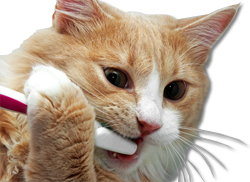
- Bad breath
- Red or swollen gums, especially if they are painful or bleed
- Drooling
- Difficulty eating or chewing
- Loose or missing teeth
- Receded gums
- Gingival overgrowth up onto a crown may signal an erosive lesion into
the crown and a tooth that may need extraction - Yellow-brown tartar or tan plaque build-up on the tooth crowns
- Pawing or rubbing at the face
Home Dental Care
We recommend brushing your cat’s teeth every day. If you are unable to brush daily, once every other day is acceptable. Introduce your kitten to teeth brushing at an early age so they will be more willing to let you brush their teeth, as they get older.
What is involved in a typical dental cleaning?
A dental cleaning in a cat is very similar to a dental cleaning that you would receive by your dental hygienist, except that a cat would not sit still in a chair to have their teeth cleaned and therefore requires general anesthesia. Since general anesthesia is needed in order to clean your cat’s teeth, a complete physical examination and baseline blood work is performed to ensure that there are no unnecessary risks for anesthesia. We require blood work be completed within 30 days prior to any anesthetic procedure.
During the dental cleaning, a periodontal probe is used to check for pockets underneath the gum line where periodontal disease starts. An ultrasonic scaler is used to remove large pieces of tartar and a hand scaler is used to remove tartar from crevices and underneath the gum line. The teeth are then polished to smooth out any scratches in the enamel surface. A fluoride treatment is also applied to the teeth at this time.
Dental radiographs, or x-rays, are also important in evaluating dental disease below the gum line. It is often essential to have dental radiographs of suspicious teeth to determine if they can be saved or if extraction is necessary. If extractions are needed, every effort will be made to keep your cat comfortable including local nerve blocks and appropriate pain management medications prior and after extractions. In most cases, cats with painful teeth show dramatic improvement within a couple of days of the extractions!
Don’t ignore the early signs of dental disease. Regular, preventative dental care is the best way to avoid serious dental disease, tooth loss, oral pain and other health problems.
Heartworm Disease also affects cats!!!!
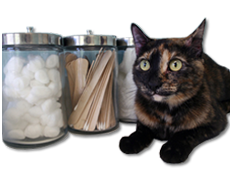
Yes! Cats are at risk for heartworm disease too!! Even indoor only cats can be affected. In fact up to 33% of reported cases are in cats who are described by their owners as strictly indoors. For cats, the prevalence of heartworm infection is directly related to the number of infected dogs in the area. Age is not a risk factor either; cats of any age can be affected.
How Does Heartworm Disease Occur?
The cycle begins when a mosquito bites an infected dog or cat and ingests heartworm larvae into its own bloodstream. When this mosquito carrying the infective larvae then bites into a cat for a blood meal, these infective larvae are injected under the skin of the cat. The larvae grow for 3-4 months and eventually make their way into the heart where they develop into adults and can cause serious life threatening problems for your cat. It takes approximately 8 months for the heartworms to enter the host, develop into mature worms and produce offspring.
Symptoms of Heartworm Disease in Your Cat:
Cats can have a wide range of symptoms, with some having no symptoms at all. Clinical signs can be very non-specific, and may mimic many other feline diseases, which makes diagnosing heartworm disease often difficult. Signs associated with the first stage of heartworm disease are associated with the heartworms entering the blood vessels and being carried to the pulmonary arteries. It can often be misdiagnosed as asthma or allergic bronchitis during this stage, but it is now known as HARD (Heartworm Associated Respiratory Disease). Symptoms do not usually occur until damage has already occurred to the heart.
Signs include:
- Difficulty breathing
- Coughing
- Vomiting/diarrhea
- Collapsing
- Lethargy
- Anorexia
- Weight loss
- Decreased ability to exercise
- Sudden death
There is NO approved treatment for heartworm disease in the cat once a cat is infected; therefore PREVENTION IS THE KEY!
Heartworm Prevention:
Heartworms are preventable NOT treatable! A simple chewable “treat-like” pill given orally or a liquid applied to the skin to your cat once a month year-round is all it takes. This preventative treatment should begin after a blood test has been conducted to determine if your cat has already been exposed or is infected.
PREVENTION IS THE KEY TO KEEPING YOUR CAT SAFE FROM HEARTWORM DISEASE!
To find out more information about heartworm disease, check out the following websites:
American Heartworm Society: www.heartwormsociety.org
Association of Feline Practitioners: www.catvets.com
Companion Animal Parasite Council: www.petsandparasites.org
Pfizer Corporation: www.knowheartworms.org
BRINGING YOUR CAT TO THE VETERINARIAN
A Cat’s Behavior:
- Cats are comfortable with what is familiar and need time to adjust to the unfamiliar. Respect your cat’s need to become familiar with new people, places and situations.
- Stay calm. Cats can sense our anxiety or frustrations.
- Cats do not learn from punishment or force. Use positive reinforcement by giving rewards (treats). Treats can be in the form of food, play or affection. Be persistent and reward every time.
Becoming comfortable with the Carrier:
- The goal is help your cat learn to associate the carrier with positive experiences and enter the carrier voluntarily.
- Make the carrier a familiar place in the home by leaving it in a room your cat spends most of its time.
- Place familiar soft bedding inside the carrier.
- Place treats, catnip, or toys inside the carrier to encourage the cat to enter.
- It may take days or weeks before your cat starts to trust the carrier. Continue to remain calm and patient and reward desired behaviors.
- If you still have trouble, the carrier itself may need to be assessed. There are many different versions and sizes of cat carriers. A different carrier may be best for your cat.
Getting an Unwilling cat into the Carrier:
- Place the carrier in a small room with few hiding places. Bring the cat into the room and close the door. Move slowly and calmly. Encourage your cat to enter the carrier by using treats or toys. Don’t chase the cat to get it into the carrier.
- If your cat will not walk into the carrier and there is an opening on the top, gently pick your cat up and lower it into the carrier. Another option is to remove the top half of the carrier and then calmly replace the top.
- Use familiar bedding inside. Also consider using synthetic feline facial pheromone (FeliwayÒ) spray into the carrier at least 30 minutes prior to transport to help calm the cat.
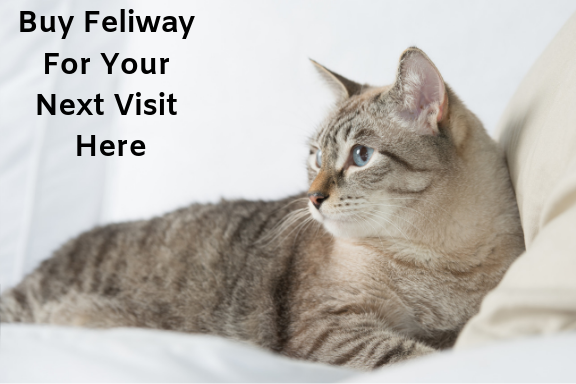

Coming Home- Keep the Peace in a Multi-cat Household:
- Aggressive behavior can occur when one cat senses another as a stranger, because cats are very sensitive to smells.
- Leave the returning cat in the carrier for a few minutes to see how all the household cats react.
- If cats appear calm and peaceful, then let the cat out of the carrier.
- If there is tension between the cats or there has been conflict before, keep the cat in the carrier and take it to a separate room to avoid potential injury. Provide food, water and litter box for minimum of 24 hours while the cat regains the familiar smells of home.
- If there is still stress after this period, contact your veterinarian for more advice.
- A synthetic feline pheromone (FeliwayÒ) can help provide the sense of familiarity.
- Future visits: Use familiar bedding or clothing with your scent, as it retains the smell of home. Use synthetic feline pheromone. Bring both cats to veterinarian together, as both cats will carry the scent of the clinic.
What carriers are best:
- Inexpensive hard-sided carrier that opens from the top and the front, and can be taken apart in the middle. An easily removable top allows a cat that is fearful, anxious, or in pain to stay in the bottom of the carrier for exams.
- Avoid carriers that require the cat to be pulled or dumped out for an exam.
- Choose carriers that are sturdy, secure and stable, as well as easy to carry.
- Carriers should be seat-belted into the car to keep your cat safer and to reduce bumpiness of the ride.
- A blanket or towel covering the carrier will prevent your cat from seeing the unfamiliar sights and may help make your cat less anxious.
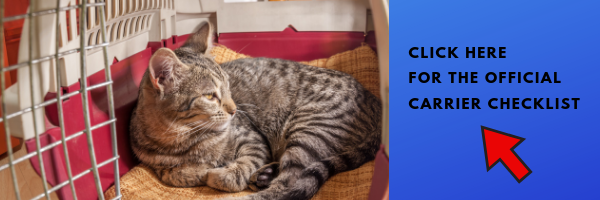

Feline Leukemia Virus (FeLV)
Feline Leukemia or FeLV is a disease that reduces the immune system’s ability to protect itself against secondary infections caused by common bacteria, viruses, protozoa and fungi.
How is Feline Leukemia Spread?
FeLV infection occurs worldwide. FeLV is transmitted through casual contact such as mutual grooming, and sharing food/water bowls through saliva and nasal secretions or litter boxes through urine and feces. It can also be spread through bite wounds and to kittens through nursing.
What are the Signs of Feline Leukemia?
Symptoms of this disease are often subtle. Cats will often show no signs of infection until the advanced stages. Symptoms may include:
- Fever
- Lethargy
- Loss of Appetite
- Weight Loss
- Pale Gums (Anemia)
- Mouth Sores
- Diarrhea
- Enlarged Lymph Nodes
- Chronic Respiratory Disease
- Lymphosarcomas
How is Feline Leukemia Diagnosed? Why should I have my cat or kitten tested?
A blood test done in hospital. Early detection of FeLV is key to maintaining the health of your cat and to prevent the spread of infection to other cats. Our recommendations for testing for FeLV are…
- Test any cat that has exposure to cats with an unknown FeLV status.
- Retest kittens at minimum 30 days after first test to ensure negative status.
- Test all new kittens
- Test cats or kittens that are ill or showing signs of FeLV
- Test cats that live an indoor/outdoor lifestyle at least yearly.
What do the Test Results Mean?
Negative- At this time your cat does not have FeLV. If there has been a recent exposure to an outdoor or stray cat, or if the cat/kitten being tested is a new adoption we recommend retesting in a minimum 30 days after the first test to confirm the negative status.
Positive- It is not possible to successfully cure FeLV infection, but many infected cats can live good quality lives with supportive care. If your cat is positive, the cat needs to kept indoors to prevent the spread to others. If there are other cats in the household, the positive cat needs to be isolated. Twice yearly veterinary visits to monitor condition- the veterinarian may recommend blood work, urinalysis and fecal exams to screen for any early signs of symptoms. Parasite control is very important as the immune system is already compromised being infected with FeLV. Cats infected with FeLV will usually deteriorate within 3-5 years of infection. Euthanasia should be performed when the quality of life becomes poor.
How To Prevent FeLVFeline Leukemia is an infectious disease that can be prevented by eliminating interactions with infected cats. An indoor lifestyle is the most effective way to limit your cats’ exposure. There is a vaccine available for FeLV that is highly recommended. Even if you think your cat will be living an “indoor” life, cats do escape outdoors and sometimes life styles change with time. Also test every newly adopted cat before exposing to your household cats.
Feline Immunodeficiency Virus (FIV)
How is FIV Spread?
FIV is contagious and spreads from cat to cat typically through biting and fighting making intact, aggressive male cats that spend time outdoors more susceptible to the disease. A high concentration of the virus is found in saliva, but has also been found in milk and can be transmitted from mother to kitten through the act of nursing.
What are the Signs of FIV?
FIV is a viral infection that attacks the immune system of cats. The FIV virus can promote a variety of symptoms including:
- Fever
- Lethargy
- Loss of Appetite
- Weight Loss
- Pale Gums (Anemia)
- Mouth Sores
- Diarrhea
- Enlarged Lymph Nodes
- Neurological Disease
- Infections caused by a poorly functioning immune system
How is FIV Diagnosed? Why should I have my cat or kitten tested?
A blood test done in hospital. Early detection of FIV is key to maintaining the health of your cat and to prevent the spread of infection to other cats. Our recommendations for testing for FIV are…
- Test any cat that has exposure to cats with an unknown FIV status.
- Retest kittens at minimum 60 days after first test to ensure negative status.
- Test all new kittens 8 weeks or older in age
- Test cats or kittens that are ill or showing signs of FIV
- Test cats that live an indoor/outdoor lifestyle at least yearly.
What do the Test Results Mean?
Negative- At this time your cat does not have FIV. If there has been a recent exposure to an outdoor or stray cat, or if the cat/kitten being tested is a new adoption, we recommend retesting in a minimum 60 days after the first test to confirm the negative status.
Positive- It is not possible to successfully cure FIV infection, but many infected cats can live good quality lives. If your cat is positive, the cat needs to kept indoors to prevent the spread to others. Twice yearly veterinary visits to monitor condition- the veterinarian may recommend blood work, urinalysis and fecal exams to screen for any early signs of symptoms. Parasite control is very important as the immune system is already compromised being infected with FIV. Euthanasia should be performed when the quality of life becomes poor.
How To Prevent FIVFIV is an infectious disease that can be prevented by eliminating interactions with infected cats. An indoor lifestyle is the most effective way to limit your cats’ exposure. Also test every newly adopted cat before exposing to your household cats.
Can Humans Get FIV?No. FIV is only known to infect cats and can only be transmitted from cat to cat. There is absolutely no evidence of a person ever having been infected with FIV.
INTESTINAL PARASITES
- Roundworms: Even if the mother cat has been dewormed, she can transmit roundworms to her kittens during nursing. Roundworms are one of the most common parasites found in kittens and can cause severe diarrhea. Your kitten may appear to have a bloated or “pot-bellied” abdomen. Roundworm eggs can easily be detected on a fecal examination. Cats are susceptible to roundworms throughout their entire life. Since roundworms can potentially be transmitted to humans, we automatically prescribe deworming medicine for all kittens. In humans, roundworms can cause blindness and children are most at risk. We recommend for owners to wash their hands well after scooping the litter box.
- Coccidiosis: Coccidia are microscopic parasites that attack the lining of the intestines and are a common cause of diarrhea in cats. These parasites can easily be treated with prescription medications.
- Tapeworms: If you see a worm on the backend of your cat, put it in a baggie along with a moist paper towel and bring it to the office. If you see little short white worms (1/2 inch long or less), these are probably tapeworm segments. When the segments dry, they look like grains of rice and may stick to your cat’s hair around the rectum. The common tapeworm of cats is harmless to humans. If you see segments under your cat’s tail or in the litter box, let us know. Although you may be seeing worms at home, our lab results may be negative if your cat has tapeworms. Prescription tapeworm medications are extremely effective, but may cause your cat to vomit the tapeworm. Non-prescription tapeworm medications are not as effective. Cats can get tapeworms from ingesting fleas or rodents.
- Hookworms: Hookworms can be transmitted in a number of ways. Queens can pass them to kittens through the placenta before birth or by nursing. They can penetrate also through the skin or be ingested if there is exposure to contaminated soil. Once the cat is infected, the worms begin reproducing and shed eggs in the feces. The adult worms attach to the lining of the small intestine and feed on blood. In severe infections, profound anemia can occur. Hookworms can be treated with a prescription dewormer. Hookworms can be passed to humans and can cause Cutaneous Larva Migrans (CLM), which is where the larvae migrate in the skin causing intensely itchy, serpentine lesions. Humans are infected by direct skin penetration of the infective larvae. It is recommended to cover children’s sandboxes when not in use, wear shoes and gloves when gardening, and to cover any exposed area of skin with a waterproof liner if extended contact with moist soil is expected.
- Whipworms: Whipworms are another type of intestinal parasite, but is not that common in cats. Whipworm infections can cause diarrhea. The cat can become infected after ingesting eggs from the environment. The eggs then hatch once they reach the stomach. It takes about 3 months for the eggs to mature to adults and begin shedding eggs. The adults can then burrow into the small intestine and feed on the blood and tissue. The eggs are intermediately passed in the feces and become infective in about 1 month. Since the eggs are not shed all the time, repeated fecal examinations may be necessary to diagnose whipworm infection. Whipworms can be treated with a dewormer.
- Giardia: Giardia is a one-celled organism that infects the small intestines of cats and many other mammals, including people. Many cases of giardia cause explosive, watery diarrhea, dehydration, weight loss and unkempt appearance. Once ingested, the infective cysts can appear in the feces 1 to 2 weeks after exposure. Most domestic animals contract giardia from drinking contaminated pond or stream water. Giardia can be treated with antibiotics.
- Campylobacter: Campylobacter is a bacterium that can infect cats. Cats kept in kennels and catteries, laboratories, and animal shelters have a much higher risk of obtaining the organism. The principal means of transmission is by fecal-oral spread, especially via food and water. Contaminated meat and unpasteurized milk are common sources of infection. The main clinical sign of illness is diarrhea containing blood and mucus. Decreased appetite and occasional vomiting can also accompany the diarrhea. Fever may also occur. In some cases, the diarrhea may last several weeks and may be either intermittent or may last for several months. Campylobacter can be treated with antibiotics.
KITTEN BEHAVIOR AND SOCIALIZATION
Kitten socialization goals before 10 weeks of age:
- Kittens should be exposed to many different people and animals.
- Kittens should be exposed to several types of noises, situations, handling techniques and scents.
- Experiences must always be non-threatening.
- Experiences should be positive and pleasant.
- Socialization is not the same as overwhelming the kitten. Watch the kitten for signs that he is fearful.
Socialization Period:
- Most receptive period is 2 to 7 weeks old.
- Kittens 2 to 7 weeks old, benefit the most from positive non-threatening experiences.
- Social play begins around 4 weeks, peaks at 7-9 weeks and declines at 12-14 weeks.
- Fearful reactions to stimuli displayed at about 6 weeks old.
- By 14 weeks of age, kittens are more likely to fight with other kittens rather than socialize with them.
Environmental Enrichment:
- Do not play with hands. If the kitten bites hands, redirect them to a toy that is appropriate to bite and chew on.
- Vertical enrichment such as commercially purchased “kitty condos”.
- Indoor gardens made of cat friendly plants, such as cat mint and cat nip.
- Tunnels, paper bags, cardboard boxes and plenty of other hiding places.
- Single cat resting perches. This is especially important for multi-cat households.
- Scratching and climbing posts, both horizontal and vertical.
- Busy boxes or puzzle toys.
- Feeding toys that let your cat “hunt” for meals.
Kitten Care and Training Tips:
- Never punish, then hand should always be a friend. Understand cats do not learn lessons through punishment, they learn to be afraid or even aggressive towards people.
- Never play or teach with hands, instead use toys.
- Provide adequate toys for cat’s play and exploratory needs.
- Teach kittens to come when called by using small food rewards or clicker training.
- Keep the cat carrier out at all times (with the door removed or open). Keep the carrier stocked with a comfortable bed, treats, catnip or favorite toys to make it the perfect hiding place.
- Introduce kittens to a variety of cat foods and treats so they may accept a diet change more readily later in life.
- Providing one litter box per cat….plus one. This decreases the chance of any territorial litter box behavior.
- Do not let kitten on or in area where you don’t want them as adults. For example, never put your kitten on the kitchen counter if you don’t want them on it as an adult.
HUMAN FOODS TO AVOID FEEDING
 |
Chocolate, Coffee, Caffeine:: These products contain methylxanthines, which are found in cacao seeds. When ingested by pets, they can cause vomiting and diarrhea, panting, excessive thirst and urination, hyperactivity, abnormal heart rhythm, tremors, seizures and even death. Darker chocolate is more dangerous than milk chocolate. White chocolate has the lowest level of methylxanthines, while baking chocolate contains the highest. |
 |
Alcohol: Alcoholic beverages and food products containing alcohol can cause vomiting, diarrhea, decreased coordination, central nervous system depression, difficulty breathing, tremors, abnormal blood acidity, coma, and even death. |
 |
Avocado: The leaves, fruit, seeds and bark contain Persin, which causes vomiting and diarrhea. |
 |
Macadamia Nuts: Commonly used in candies and cookies. These nuts have caused weakness, depression, vomiting, tremors and hyperthermia (elevated body temperature). Signs usually appear within 12 hours of ingestion and last approximately 12-48 hours. |
 |
Grapes and raisins: While the toxic substance in grapes and raisins and the minimum toxic dose is unknown, these fruits can cause kidney failure. In cats that already have certain health problems, signs may be more dramatic. |
 |
Yeast dough: Yeast dough can rise and cause gas to accumulate in your pet’s digestive system. This can be painful and can cause the stomach or intestines to rupture. Because the risk is diminished after the dough is cooked and the yeast has fully risen, pets can have small bits of bread as treats.. |
 |
Raw/undercooked Meat, Eggs, and Bones: Raw meat and raw eggs can contain bacteria such as Salmonella and E. coli that can be harmful to pets. In addition, raw eggs contain an enzyme called avidin that decreases absorption of biotin (a B vitamin), which can lead to skin and coat problems. Feeding your pet raw bones can be dangerous, as they may choke on the bones or sustain injury should the bone splinter and become lodged in or puncture your pet’s digestive tract. |
 |
Xylitol: Xylitol is a sweetener used in many products, such as gum, candy, baked goods and toothpaste. In most species, it can cause insulin release, which can lead to liver failure. The increase in insulin leads to hypoglycemia (lowered sugar levels). Initial signs of toxicosis include vomiting, lethargy and loss of coordination. These signs can progress to recumbency and seizures. Elevated liver enzymes and liver failure can be seen within a few days. |
 |
Onions, garlic, chives: These can lead to gastrointestinal irritation and could lead to red blood cell damage. Cats are the most susceptible. Toxicity is normally diagnosed through history, clinical signs and microscopic confirmation of Heinz bodies. An occasional low dose, as what might be found in pet foods or treats, will likely not cause a problem. We do not recommend that you give your pet large quantities of these foods. |
 |
Milk: Milk and other milk-based products can cause pets to have diarrhea or other digestive upset, because pets do not possess significant amounts of lactase (the enzyme that breaks down lactose in milk). |
 |
Salt: Large amounts of salt can produce excessive thirst and urination, or even sodium ion poisoning in pets. Signs that your pet may have eaten too many salty foods include vomiting, diarrhea, depression, tremors, elevated body temperature, seizures, and even death. In other words, keep those salty snacks to yourself. |
TOP 10 HUMAN MEDICATIONS THAT POISON OUR PETS
- NSAIDs: Non-steroidal anti-inflammatory drugs (NSAIDs) like ibuprofen or naproxen are the most common causes of pet poisonings. Severe problems can develop even at small doses. Cats are especially sensitive to their effects and can develop stomach and intestinal ulcers to kidney damage.
- Antidepressants: Antidepressants can cause vomiting and lethargy. Certain types can lead to serotonin syndrome, a condition that is marked by agitation; elevated body temperature, heart rate and blood pressure; disorientation; vocalization; tremors and seizures.
- Acetaminophen (Tylenol): Cats are especially sensitive to acetaminophen, which can cause damage to the red blood cells and interfere with their ability to transport oxygen.
- Methylphenidate (for ADHD): These medications act as stimulants in pets and can cause dangerous elevations in heart rates, blood pressure and body temperature, as well as cause seizures.
- Fluorouracil: In humans, it is used as an anti-cancer drug to topically treat minor skin cancers and solar keratitis. In pets, it can cause severe vomiting, seizures and cardiac arrest even in those that have chewed on the cotton swabs that were used to apply the medication.
- Isoniazid: It is used as the first line of defense against tuberculosis. It can cause a rapid onset of seizures that could result in death.
- Pseudoephedrine: It is a popular decongestant in many cold and sinus products. It acts like a stimulant when ingested by a pet. It causes elevated heart rates, blood pressure and body temperature as well as seizures.
- Anti-diabetics: Many oral diabetes treatments can cause a major drop in blood sugar levels of affected pets. Clinical signs of ingestion include disorientation, lack of coordination and seizures.
- Vitamin D derivatives: Even small exposures to Vitamin D analogues such as calcipotriene and calcitriol can cause spikes in blood calcium levels in pets. Signs of exposure may not occur for more than 24 hours after ingestion and include vomiting, loss of appetite, and increased urination and thirst due to kidney failure.
- Baclofen: Baclofen is a muscle relaxant that can impair the central nervous systems of cats. Some symptoms of ingestion include significant depression, disorientation, vocalization, seizures and coma, which can lead to death.
When does your cat needs emergency care?
Things like trauma (such as open wounds or accidents) should always be treated as an emergency situation. Other common feline emergency situations include:
- Inability or difficulty urinating:
- This a very serious and life threatening condition. The inability to urinate is most commonly seen in male cats. Signs that your cat may be having difficulty urinating are: going in and out of the litter box frequently, painful or bloated abdomen, yowling or vocalizing in pain, leaving very small spots of urine throughout the house, discolored or red urine.
- Frequent vomiting and inability to keep food down
- Cats are notorious for playing with objects that can become ingested and have to be surgically removed. At Cats Veterinary, the doctors have surgically removed things like: pieces of flip flops, strings, nickels, hair ties, pieces of blankets, and bone pieces.
- Difficulty breathing- labored breaths or open mouth breathing
- It is not normal for a cat to pant like a dog- this is sign of serious respiratory distress. Raspy-sounding breaths or very quick breathing pattern can also be a sign of distress.
- Weakness in the rear legs/ or stiff and unresponsive rear legs
- Cats are very good at hiding things- including heart disease. Weakness in any limb is an emergency situation- but weakness in the hind legs can be a sign of a Saddle Thrombus. This is when a blood clot leaves the heart and lodges in the artery supplying blood flow to the hind legs. Wellness exams and cardiac wellness checks (such as blood pressures, chest radiographs, and screening cardiac ultrasounds) are the best way to monitor your cats’ heart health as they age.
- Neurologic symptoms such as active seizures, head tilts, circling
- Consumption of poisons, toxic plants or medications- there are lists provided on our website of commonly ingested poisonous items. If you cat ingests anything suspicious it is recommended to call the ASPCA Animal Poison Control Center at 1-888-426-4435.
This list is not an all inclusive list of serious feline medical conditions, the recommendation for any condition in question is to call a veterinary office for a professional opinion. If Cats Veterinary is closed we recommend calling Advanced Animal Emergency (located directly behind the clinic in the same parking lot) at 586-466-6133.
Signs or Symptoms of Feline Disease and Medical Conditions
- Feline Diabetes- Signs or symptoms of feline diabetes tend to include:
- Increase in appetite
- Weight Loss
- Increase in thirst
- Increase in urine production
- Feline Hyperthyroidism- signs or symptoms of feline hyperthyroidism tend to include:
- Increase in appetite
- Weight Loss
- Increase in activity
- Feline Kidney Disease- signs or symptoms of feline chronic kidney disease tend to include:
- Increase in thirst
- Increase in urine production
- Weight loss
- Foul smelling breath
- Feline Dental Disease
- Foul smelling breath
- Drooling
- Pawing at face
- Feline Arthritis
- Limping
- Not grooming as much- especially over the back end
- Reluctance to jump
- Feline Constipation
- Hard round and small stools
- Vomiting
- Loss of appetite
- Feline Urinary Tract Infection/ Urination Blockage/ Cystitis or Bladder Inflammation
- Going in and out of the litter box multiple times and producing small amounts
- Urinating outside the litter box
- Urinating blood or orange-pink colored urine
- **The inability to urinate is an emergency and your cat should be seen immediately by a veterinarian. If your office is close seek out an emergency clinic**





